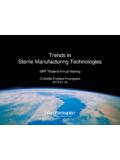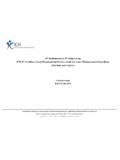Transcription of Q 7 Good Manufacturing Practice for Active …
1 European Medicines Agency 7 Westferry Circus, Canary Wharf, London, E14 4HB, UK Tel. (44-20) 74 18 85 75 Fax (44-20) 75 23 70 40 E-mail: EMEA 2006 Reproduction and/or distribution of this document is authorised for non commercial purposes only provided the EMEA is acknowledged November 2000 CPMP/ICH/4106/00 ICH Topic Q 7 good Manufacturing Practice for Active Pharmaceutical Ingredients Step 5 NOTE FOR GUIDANCE ON good Manufacturing Practice FOR Active PHARMACEUTICAL INGREDIENTS (CPMP/ICH/4106/00) TRANSMISSION TO CPMP July 2000 RELEASE FOR CONSULTATION July 2000 DEADLINE FOR COMMENTS September 2000 SUBMISSION TO CPMP FOR INFORMATION November 2000 RELEASE FOR INFORMATION November 2000 Note: Date for coming into operation for this guideline will be released by the European Commission, DG Enterprise, Unit for Pharmaceuticals ( ). EMEA 2006 2 good Manufacturing Practice FOR Active PHARMACEUTICAL INGREDIENTS TABLE OF CONTENTS Section Title 1 Introduction Objective Regulatory Applicability Scope 2 Quality Management Principles Responsibilities of the Quality Unit(s) Responsibility for Production Activities Internal Audits (Self-Inspection)
2 Product Quality Review 3 Personnel Personnel Qualifications Personnel Hygiene Consultants 4 Buildings and Facilities Design and Construction Utilities Water Containment Lighting Sewage and Refuse Sanitation and Maintenance 5 Process Equipment Design and Construction Equipment Maintenance and Cleaning Calibration Computerized Systems 6 Documentation and Records Documentation System and Specifications Equipment Cleaning and Use Record Records of Raw Materials, Intermediates, API Labelling and Packaging Materials Master Production Instructions (Master Production and Control Records) Batch Production Records (Batch Production and Control Records)
3 Laboratory Control Records Batch Production Record Review 7 Materials Management EMEA 2006 3 General Controls Receipt and Quarantine Sampling and Testing of Incoming Production Materials Storage Re-evaluation 8 Production and In-Process Controls Production Operations Time Limits In-process Sampling and Controls Blending Batches of Intermediates or APIs Contamination Control 9 Packaging and Identification Labelling of APIs and Intermediates General Packaging Materials Label Issuance and Control Packaging and Labelling Operations 10 Storage and Distribution Warehousing Procedures Distribution Procedures 11 Laboratory Controls General Controls Testing of Intermediates and APIs Validation of Analytical Procedures Certificates of Analysis Stability Monitoring of APIs Expiry and Retest Dating Reserve/Retention Samples 12 Validation Validation Policy Validation Documentation Qualification Approaches to Process Validation Process Validation Program Periodic Review of Validated Systems Cleaning Validation Validation of Analytical Methods 13 Change Control 14 Rejection and Reuse of Materials Rejection Reprocessing Reworking Recovery
4 Of Materials and Solvents EMEA 2006 4 Returns 15 Complaints and Recalls 16 Contract Manufacturers (including Laboratories) 17 Agents, Brokers, Traders, Distributors, Repackers, and Relabellers Applicability Traceability of Distributed APIs and Intermediates Quality Management Repackaging, Relabelling and Holding of APIs and Intermediates Stability Transfer of Information Handling of Complaints and Recalls Handling of Returns 18 Specific Guidance for APIs Manufactured by Cell Culture/Fermentation General Cell Bank Maintenance and Recordkeeping Cell Culture/Fermentation Harvesting, Isolation, and Purification Viral Removal/Inactivation Steps 19 APIs for Use in Clinical Trials General Quality Equipment and Facilities Control of Raw Materials Production Validation Changes Laboratory Controls Documentation 20 Glossary EMEA 2006 5 1 Introduction Objective This document (Guide) is intended to provide guidance regarding good Manufacturing Practice (GMP) for the Manufacturing of Active pharmaceutical ingredients (APIs) under an appropriate system for managing quality.
5 It is also intended to help ensure that APIs meet the requirements for quality and purity that they purport or are represented to possess. In this Guide Manufacturing is defined to include all operations of receipt of materials, production, packaging, repackaging, labelling, relabelling, quality control, release, storage and distribution of APIs and the related controls. In this Guide the term should indicates recommendations that are expected to apply unless shown to be inapplicable or replaced by an alternative demonstrated to provide at least an equivalent level of quality assurance. For the purposes of this Guide, the terms current good Manufacturing practices and good Manufacturing practices are equivalent. The Guide as a whole does not cover safety aspects for the personnel engaged in the manufacture, nor aspects of protection of the environment.
6 These controls are inherent responsibilities of the manufacturer and are governed by national laws. This Guide is not intended to define registration/filing requirements or modify pharmacopoeial requirements. This Guide does not affect the ability of the responsible regulatory agency to establish specific registration/filing requirements regarding APIs within the context of marketing/ Manufacturing authorizations or drug applications. All commitments in registration/filing documents must be met. Regulatory Applicability Within the world community, materials may vary as to the legal classification as an API. When a material is classified as an API in the region or country in which it is manufactured or used in a drug product, it should be manufactured according to this Guide. Scope This Guide applies to the manufacture of APIs for use in human drug (medicinal) products.
7 It applies to the manufacture of sterile APIs only up to the point immediately prior to the APIs being rendered sterile. The sterilization and aseptic processing of sterile APIs are not covered by this guidance, but should be performed in accordance with GMP guidelines for drug (medicinal) products as defined by local authorities. This Guide covers APIs that are manufactured by chemical synthesis, extraction, cell culture/fermentation, by recovery from natural sources, or by any combination of these processes. Specific guidance for APIs manufactured by cell culture/fermentation is described in Section 18. This Guide excludes all vaccines, whole cells, whole blood and plasma, blood and plasma derivatives (plasma fractionation), and gene therapy APIs. However, it does include APIs that are produced using blood or plasma as raw materials.
8 Note that cell substrates (mammalian, plant, insect or microbial cells, tissue or animal sources including transgenic animals) and early process steps may be subject to GMP but are not covered by this Guide. In addition, the Guide does not apply to medical gases, bulk-packaged drug (medicinal) products, and Manufacturing /control aspects specific to radiopharmaceuticals. Section 19 contains guidance that only applies to the manufacture of APIs used in the production of drug (medicinal) products specifically for clinical trials (investigational medicinal products). EMEA 2006 6 An API Starting Material is a raw material, intermediate, or an API that is used in the production of an API and that is incorporated as a significant structural fragment into the structure of the API. An API Starting Material can be an article of commerce, a material purchased from one or more suppliers under contract or commercial agreement, or produced in-house.
9 API Starting Materials normally have defined chemical properties and structure. The company should designate and document the rationale for the point at which production of the API begins. For synthetic processes, this is known as the point at which "API Starting Materials" are entered into the process. For other processes ( fermentation, extraction, purification, etc), this rationale should be established on a case-by-case basis. Table 1 gives guidance on the point at which the API Starting Material is normally introduced into the process. From this point on, appropriate GMP as defined in this Guide should be applied to these intermediate and/or API Manufacturing steps. This would include the validation of critical process steps determined to impact the quality of the API. However, it should be noted that the fact that a company chooses to validate a process step does not necessarily define that step as critical.
10 The guidance in this document would normally be applied to the steps shown in gray in Table 1. It does not imply that all steps shown should be completed. The stringency of GMP in API Manufacturing should increase as the process proceeds from early API steps to final steps, purification, and packaging. Physical processing of APIs, such as granulation, coating or physical manipulation of particle size ( milling, micronizing), should be conducted at least to the standards of this Guide. This GMP Guide does not apply to steps prior to the introduction of the defined "API Starting Material". EMEA 2006 7 Table 1: Application of this Guide to API Manufacturing Type of Manufacturing Application of this Guide to steps (shown in grey) used in this type of Manufacturing Chemical Manufacturing Production of the API Starting Material Introduction of the API Starting Material into process Production of Intermediate(s) Isolation and purification Physical processing, and packaging API derived from animal sources Collection of organ, fluid, or tissue Cutting, mixing, and/or initial processing Introduction of the API Starting Material into process Isolation and purification Physical processing, and packaging API extracted from plant sources Collection of plant Cutting and initial extraction(s)














